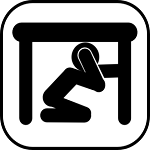 “The United States of America, right now, has the strongest, most durable economy in the world,” said President Obama, in his State of the Union address, on Tuesday night. What performance metrics he based his assertion on is unclear. But we’ll give him the benefit of the doubt.
“The United States of America, right now, has the strongest, most durable economy in the world,” said President Obama, in his State of the Union address, on Tuesday night. What performance metrics he based his assertion on is unclear. But we’ll give him the benefit of the doubt.
Maybe this is so…right now. But it isn’t eternal. For at grade, hidden in plain sight, a braid of positive and negative surface flowers indicate an economic strike-slip fault extends below. What’s more, the economy’s foundation dangerously straddles across it.
Something must slip. A massive vertical rupture is coming that will collapse everything within a wide-ranging proximity. It is not a matter of if it will come. But, rather, of when…regardless of what the President says.
Here at the Economic Prism we have no reservations about the U.S. – or world – economy. We see absurdities and inconsistencies. We see instabilities perilously pyramided up, which could rapidly cascade down. We just don’t know when.
Comprehending and connecting the infinite nodes and relationships within an economy are beyond even the most intelligent human’s capacity. Cause and effect chains are not always immediately observable. Feedback loops are often circuitous and unpredictable. What is at any given moment may not be what it appears.
Not Without Consequences
For instance, the Federal Reserve quadrupled its balance sheet following the 2008 financial crisis, yet consumer prices hardly budged. Undeniably, the Bureau of Labor Statistics’ consumer price index is subject to gross manipulation. We’re not endorsing the veracity of the CPI.
We’re merely pointing out there’s been policies that have massively increased the quantity of money, yet we can still get a hot cup of donut shop coffee for less than a buck. Obviously, the effects of these policies have shown up in certain assets…like U.S. stocks. That’s not to say they won’t still show up in consumer prices. They most definitely will.
The point is no one really knows when consumer prices will rapidly rise. The potential is very real. Like desert scrub tumbling along a highway edge, one little spark could send prices up in a bush fire. Moreover, the longer the Fed can seemingly get away with their efforts to inflate in perpetuity, the greater the disaster that awaits us.
In the meantime, their policies are not without consequences. Price distortions flourish to the extent they appear normal. Nevertheless, upon second glance, apparent incongruities greet us everywhere we look.
The sad fact is an honest day’s work has been debased to where it’s no longer rewarded with an honest day’s pay. At the same time the positive effects of productive labor, diligent savings, and prudent spending now take a lifetime – or more – to fully manifest. Conversely, the negative effects of borrowing gobs of money and taking abundant risks can masquerade as shrewd business acumen for extended bubble periods.
Earthquake Economics
During an economic boom, particularly a boom puffed up with the Fed’s cheap credit, madmen get rich. They borrow money at an artificial discount and place big bets on rising asset prices.
They don’t care they are placing those bets within a dangerous seismic zone. The rewards are too great. Eventually asset bubbles always exhaust themselves. Price movements reverse. They stop inflating. They start deflating.
Subsequently, as the bubble exhales, the risk taking beneficiaries of the expansion are exposed. The downside, no doubt, is less pleasant than the upside. Ask U.S. oil shale producers. Just 18 months ago they were raking in cash hand over fist. Lenders were tripping over themselves to extend credit for fracked wells.
But how quickly things change. Oil prices fell below $30 per barrel on Tuesday. Break even costs for many producers is double that – or more. In other words, lenders and borrowers alike are staring face to face with the downside.
In fact, according to a report from AlixPartners, North American oil-and-gas producers are losing nearly $2 billion every week at current prices. Naturally, capital could only be misdirected to this extent under errant central bank policies of mass credit creation. Several more slips like this one and the President’s strongest, most durable economy in the world could backslide into recession.
On top of that, ‘the big one’ could rupture at any moment.
Sincerely,
MN Gordon
for Economic Prism





Pingback: Earthquake Economics——-Mind The Dangerous Fault Lines Below | David Stockman's Contra Corner